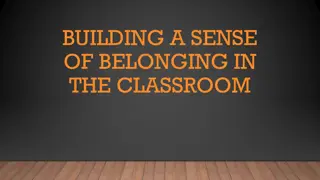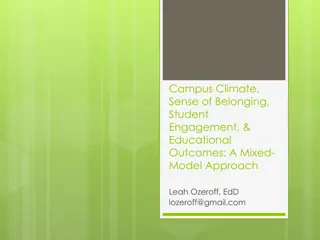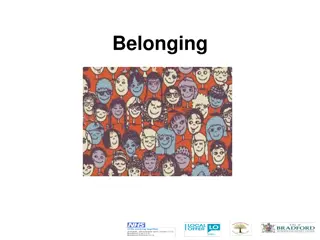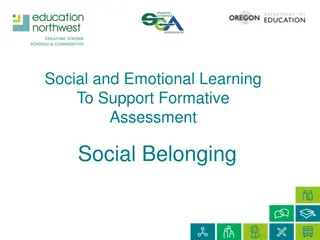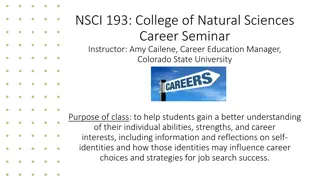
Importance of Student Sense of Belonging in Education
Explore the concept of student sense of belonging in education, its impact on academic success, and strategies to enhance it. Discover how fostering a sense of belonging influences students' mindset and academic performance, ultimately leading to better outcomes in learning.
Download Presentation

Please find below an Image/Link to download the presentation.
The content on the website is provided AS IS for your information and personal use only. It may not be sold, licensed, or shared on other websites without obtaining consent from the author. If you encounter any issues during the download, it is possible that the publisher has removed the file from their server.
You are allowed to download the files provided on this website for personal or commercial use, subject to the condition that they are used lawfully. All files are the property of their respective owners.
The content on the website is provided AS IS for your information and personal use only. It may not be sold, licensed, or shared on other websites without obtaining consent from the author.
E N D
Presentation Transcript
BELONGING COUNTS IMACC | APRIL 5, 2024 DAWN PETERSON, ED.D.
OBSERVATIONS Student mindset: I am not, nor will I ever be good at math Uncomfortable, hesitant, or even unwilling to engage with others Students who are isolated from their classmates are less successful than those who interact with their peers
THEORETICAL PERSPECTIVE Maslow s Hierarchy of Needs Basic human need Fundamental human motivation (Baumeister & Leary, 1995; Goodenow, 1993; Lahdenper & Nieminen, 2020; Maslow, 1943; Strayhorn, 2019; Tinto, 2017)
DEFINITION Sense of belonging pertains to students perception of mattering, of being accepted and respected, of believing they are a valued member of a classroom community, and of sensing their ideas and opinions are taken seriously by the classroom instructor and their peers.
IMPORTANCE OF SENSE OF BELONGING Gaining knowledge and fulfilling one s potential cannot be met until belonging is satisfied Students cannot attend to the task at hand until sense of belonging is fulfilled Belonging is not experienced in the same way by all individuals Sense of belonging depends on context (Baumeister & Leary, 1995; Freeman et al., 2007; Goodenow, 1993; Strayhorn, 2019)
OUTCOMES OF STUDENT SENSE OF BELONGING Academic success Persistence Sense of belonging Self- efficacy Motivation (Bean & Eaton, 2001; Buskirk-Cohen & Plants, 2019; Freeman et al., 2007; Gopalan & Brady, 2020; Han et al., 2017; Hausmann et al., 2007; Strayhorn, Better mental health Retention 2019; Zumbrunn et al., 2014)
1 Determine whether students have a sense of belonging in General Education Mathematics (Math 110) 2 PURPOSE OF THE STUDY Determine what teaching and learning strategies positively influence students sense of belonging 3 Determine what teaching and learning strategies positively impact students academic performance
DISCUSSION Is there a class you teach in which students seem to have a strongsense of belonging? Is there a class where sense of belonging seems to be lacking? Why might these differences in sense of belonging exist?
MEASURING SENSE OF BELONGING Classroom Community Scale (Rovai, 2002) 20 statements, Likert scale Sample statements I feel reluctant to speak openly I feel confident that others will support me I feel that students in this class care about each other I feel isolated in this class
SURVEY RESULTS I feel that this class does not promote a desire to learn (4.59) I feel that other students do not help me learn (4.30) I feel that my educational needs are not being met (4.56) I feel isolated in this class (4.22) I do not feel a sense of belonging in this class (4.22) I feel that I receive timely feedback (4.52) I feel that I am encouraged to ask questions (4.07) I feel that it is hard to get help when I have a question (4.52) I feel reluctant to speak openly (4.00) I feel that I am given ample opportunities to learn (4.48)
DISCUSSION What teaching and learning strategies do you think positively influencestudents sense of belonging? What strategies might negatively influence students sense of belonging?
WHAT STUDENTS DIDNT CARE FOR Practicing independently Working problems on the board
VERY POSITIVE IMPACT ON SENSE OF BELONGING 01 02 03 Taking notes Correcting quizzes for credit Working with others to correct quizzes for credit
Letting us choose our own groups, being able to switch them up, working as one huge group or working on our own you let us choose what worked best for us each day. STUDENT VOICES: SENSE OF BELONGING
DISCUSSION What teaching and learning strategies do you think positively impact students academic performance? What teaching and learning strategies do you think negatively impact students academic performance?
STUDENTS FELT MEH ABOUT No grade penalty for submitting online homework after the due date (no impact = 7, negative impact = 1)
VERY POSITIVE IMPACT ON ACADEMIC PERFORMANCE 01 02 03 Taking notes Completing practice problems with a group Choosing format for project Choosing a topic for the finance project
Sharing multiple ways to approach a problem is helpful, especially because we got to decide what worked best for us. We weren t accountable for every approach STUDENT VOICES: ACADEMIC PERFORMANCE
VERY POSITIVE OR POSITIVE IMPACT ON SENSE OF BELONGING AND ACADEMIC PERFORMANCE 01 02 03 Taking notes Choosing a topic for the finance project Group quizzes & assignments Correcting quizzes for credit
You believed in us. It was never you re going to fail, but how you can succeed. And then you explained things different ways until everyone got it. STUDENT VOICES: BEST OF BOTH WORLDS
FOSTERING SENSE OF BELONGING Institution In-person classroom Student participation & interaction Teamwork & cooperative learning Learn names Diverse teaching strategies Make course content relevant Online classroom Instructors are engaged, relational, & personal Task-focused and socially-oriented discussions Synchronous class meetings Rich interactions with course content Promote shared academic and social experiences Students interact meaningfully with faculty and staff Smooth academic and social transition to college (Benander, 1990; Berry, 2019; Cavanaugh, 2019; Darling, 2019; Dyer et al., 2018; Freeman et al., 2007; Gooblar, 2019; Hausmann et al., 2007; Hurtado & Carter, 1997; D. R. Johnson et al., 2007; Kraus & Sears, 2008; Lahdenper & Nieminen, 2020; Nieto & Valery, 2006; St- Amand et al., 2017; Tinto, 2017; Strayhorn, 2019; Yuan & Kim, 2014; Zumbrunn et al., 2014)
THANK YOU FOR YOUR PARTICIPATION This Photo by Unknown Author is licensed under CC BY-NC
REFERENCES Baumeister, R. F., & Leary, M. R. (1995). The need to belong: Desire for interpersonal attachments as a fundamental human motivation. Psychological Bulletin, 117(3), 497-529. Bean, J., & Eaton, S. (2001). The psychology underlying successful retention practices. Journal of College Student Retention, 3(1), 73 89. https://doi.org/10.2190/6R55-4B30-28XG-L8U0 Benander, L., Cavanaugh, L., & Rubenzahl, I. (1990). Ideas in practice: A new equation in developmental mathematics. Journal of Developmental Education, 14(1), 26-28. Berry, S. (2019). Teaching to connect: Community-building strategies for the virtual classroom. Online Learning, 23(1), 164 183. https://files.eric.ed.gov/fulltext/EJ1210946.pdf Buskirk-Cohen, A. A., & Plants, A. (2019). Caring about success: Students perceptions of professors caring matters more than grit. International Journal of Teaching and Learning in Higher Education, 31(1), 108 114. Cavanagh, S. R. (2019). How to make your teaching more engaging. Chronicle of Higher Education. https://www.chronicle.com/article/how-to-make-your-teaching-more-engaging Darling, F. (2019). Teachin it! Breakout moves that break down barriers for community college students. Teachers College Press. Dyer, T., Aroz, J., & Larson, E. (2018). Proximity in the online classroom: Engagement, relationships, and personalization. Journal of Instructional Research, 7, 108 118.
REFERENCES (CONT.) Freeman, T. M., Anderman, L. H., & Jensen, J. M. (2007). Sense of belonging in college freshmen at the classroom and campus levels. Journal of Experimental Education, 75(3), 203 220. Gooblar, D. (2019). The missing course: Everything they never taught you about college teaching. Harvard University Press. Goodenow, C. (1993). The psychological sense of school membership among adolescents: Scale development and educational correlates. Psychology in the Schools, 30(1), 79 90. Gopalan, M., & Brady, S. T. (2020). College students sense of belonging: A national perspective. Educational Researcher, 49(2), 134 137. Han, C., Farruggia, S. P., & Moss, T. P. (2017). Effects of academic mindsets on college students achievement and retention. Journal of College Student Development, 58(8), 1119 1134. https://doi.org/10.1353/csd.2017.0089 Hausmann, L., Schofield, J., & Woods, R. (2007). Sense of belonging as a predictor of intentions to persist among African American and white first-year college students. Research in Higher Education, 48(7), 803 839. https://doi.org/10.1007/s11162- 007-9052-9 Hurtado, S., & Carter, D. F. (1997). Effects of college transition and perceptions of the campus racial climate on Latino students sense of belonging. Sociology of Education, 70(4), 324 345. https://www.jstor.org/stable/2673270
REFERENCES (CONT.) Johnson, D. R., Soldner, M., Leonard, J. B., Alvarez, P., Inkelas, K. K., Rowan-Kenyon, H. T., & Longerbeam, S. D. (2007). Examining sense of belonging among first-year undergraduates from different racial/ethnic groups. Journal of College Student Development, 48(5), 525-542. Kraus, S., & Sears, S. (2008). Teaching for the millennial generation: Student and teacher perceptions of community building and individual pedagogical techniques. Journal of Effective Teaching, 8(2), 32 39. Lahdenper , J., & Nieminen, J. H. (2020). How does a mathematician fit in? A mixed-methods analysis of university students sense of belonging in mathematics. International Journal of Research in Undergraduate Mathematics Education, 6(3), 475 494. https://doi.org/10.1007/s40753-020-00118-5 Maslow, A. H. (1943). A theory of human motivation. Psychological Review, 50(4), 370 396. Nieto, J., & Valery, S. (2006). Creating a sense of community in the classroom. Journal of Pedagogy, Pluralism, and Practice, 3(3), Article 5. https://digitalcommons.lesley.edu/jppp/vol3/iss3/5 St-Amand, J., Girard, S., & Smith, J. (2017). Sense of belonging at school: Defining attributes, determinants, and sustaining strategies. IAFOR Journal of Education, 5(2), 105 119.
REFERENCES (CONT.) Strayhorn, T. L. (2019). College students' sense of belonging: A key to educational success for all students (2nd ed.). Routledge. Tinto, V. (2017). Through the eyes of students. Journal of College Student Retention: Research, Theory & Practice, 19(3), 254 269. Yuan, J., & Kim, C. (2014). Guidelines for facilitating the development of learning communities in online courses. Journal of Computer Assisted Learning, 30(3), 220 232. https://doi.org/10.1111/jcal.12042 Zumbrunn, S., McKim, C., Buhs, E., & Hawley, L. R. (2014). Support, belonging, motivation, and engagement in the college classroom: A mixed method study. Instructional Science: An International Journal of the Learning Sciences, 42(5), 661 684.








